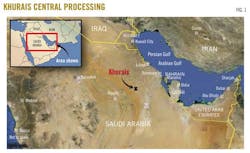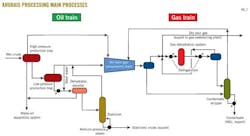Gas plant improves C3 recovery with Lean Six Sigma approach
Kamarul A. Amminudin
Thenyan S. Enezi
Mustafa A. Jubran
Ali T. Hajji
Abdulkareem S. Enizi
Zaid F. Bedoukhi
Saudi Aramco
Khurais
| Based on a presentation to 19th Annual Technical Conference of the GCC Chapter of the Gas Processors Association, May 4, 2011, Kuwait. |
Saudi Aramco's Khurais central processing plant has improved propane recovery from its gas train following performance analysis that relied on Lean Six Sigma tools. The Khurais producing department adopted the methodology, traditionally employed as a process-improvement tool throughout such non-process engineering activities as inventory management, transportation, and marketing, to address lower propane content in Khurais NGLs.
The methodology strictly follows the framework "define, measure, analyze, improve, and control" (DMAIC; see accompanying explanation, p. 106). The department defined the problem through statistical analysis of the current performance and quantification of the propane losses. The process also involved a brainstorming session to identify the potential root cause of the problem (box above).
Based on this approach, we gathered information and analyzed it to verify the root cause, identified as poor chilling performance in the gas train. We then shifted focus to improve the chiller's performance from minimizing the process stream's pressure drop across the chillers to maximizing propane refrigeration performance. The team then implemented these findings through a series of performance tests, which successfully confirmed that propane recovery can be maximized to meet the target.
Since the test was successfully completed in January 2011, followed then by ongoing monitoring, the train has sustained optimum performance to date by consistently producing a much higher NGL yield.
Khurais processing
Saudi Aramco in June 2009 commissioned the Khurais central processing plant, which lies about midway between Riyadh and Dhahran (Fig. 1). It was to produce 1.2 million b/d of Arabian Light crude oil together with associated gas and condensate from three major fields: Khurais, Abu Jiffan, and Mazalij. It also can supply water for field injection from a seawater treatment plant.
Fig. 2 shows the process flow of Khurais central processing, which includes the Khurais gas train. Crude oil from the fields is first processed in the oil train, which produces stabilized crude from a series of separation systems: the high-pressure production trap (HPPT), low-pressure production trap (LPPT), and the stabilizer. On-specification stabilized crude is then sent to the terminals for export.
The natural gas separated by the oil train is then compressed by a compression train before being sent to the Khurais gas train, which further separates it through dehydration, refrigeration, and stripping to meet a hydrocarbon dewpoint requirement. The sour-gas product from the gas train is then sent via pipeline to another gas plant for sweetening.
The condensate recovered from the gas train stripper is sent to another fractionation plant for further processing. In addition, supporting these processes is a utility system to provide steam and other utilities; power is supplied from an external source, however.
Displaying 1/5 Page1, 2, 3,4, 5Next>
View Article as Single page



